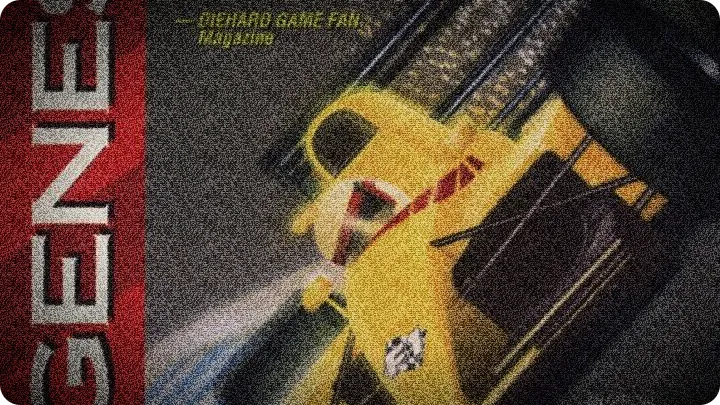 Quick fun fact — the team behind this F1 title actually held the official Formula One license, which in 1993 was a big deal. They had access to real circuit names and layouts but not modern telemetry or high-res photography. Much of the track design came from paper maps and grainy black-and-white references, making their effort to capture each circuit’s unique feel all the more impressive.
Quick fun fact — the team behind this F1 title actually held the official Formula One license, which in 1993 was a big deal. They had access to real circuit names and layouts but not modern telemetry or high-res photography. Much of the track design came from paper maps and grainy black-and-white references, making their effort to capture each circuit’s unique feel all the more impressive.
 That explains the faithfulness to circuit shapes. Now we’re in the cockpit — Grand Prix selected, eight laps at Silverstone. You can fine-tune the car before the start: gear ratios, tire pressure, and a basic downforce setting. It feels refreshingly hands-on for a 1993 racer.
That explains the faithfulness to circuit shapes. Now we’re in the cockpit — Grand Prix selected, eight laps at Silverstone. You can fine-tune the car before the start: gear ratios, tire pressure, and a basic downforce setting. It feels refreshingly hands-on for a 1993 racer.
Gameplay Highlights
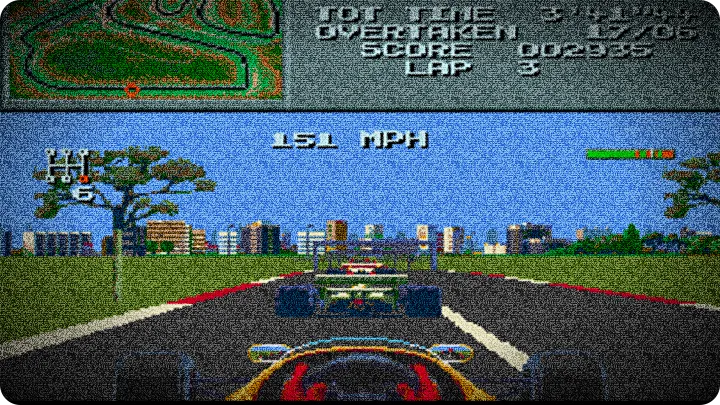
 Right away, the controls feel tight. Steering has weight, and braking into slow corners demands anticipation. Arcade mode is ideal for quick races — pick any circuit and lap count (4, 8, or 12) to learn each track’s rhythm.
Right away, the controls feel tight. Steering has weight, and braking into slow corners demands anticipation. Arcade mode is ideal for quick races — pick any circuit and lap count (4, 8, or 12) to learn each track’s rhythm.
 The circuits themselves vary nicely. Britain and Italy reward late braking and commitment; Germany’s long straights emphasize top speed; Japan tests precision with its tricky technical sections. The AI behaves predictably — aggressive early, cautious later — so overtakes feel strategic rather than chaotic.
The circuits themselves vary nicely. Britain and Italy reward late braking and commitment; Germany’s long straights emphasize top speed; Japan tests precision with its tricky technical sections. The AI behaves predictably — aggressive early, cautious later — so overtakes feel strategic rather than chaotic.
 Visually, it’s pure 16-bit charm: pixel edges, short draw distance, but a clean and useful HUD. The split-screen two-player mode is a huge plus. I still remember those couch battles that turned the TV into a checkerboard of competition. Sound design is simple but effective — engine notes change with RPM and gear, giving solid feedback even with minimal music.
Visually, it’s pure 16-bit charm: pixel edges, short draw distance, but a clean and useful HUD. The split-screen two-player mode is a huge plus. I still remember those couch battles that turned the TV into a checkerboard of competition. Sound design is simple but effective — engine notes change with RPM and gear, giving solid feedback even with minimal music.
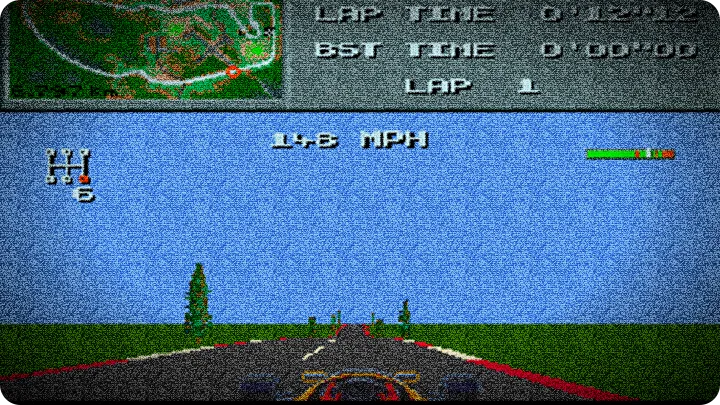
Hot Tips
- Grand Prix setup: On tracks with long straights (Germany, Italy), lower downforce and lengthen gears for more top speed. On technical circuits (Japan, Portugal), add downforce and shorten gears for better corner exits.
- Lap count strategy: Use 4-lap Arcade races to learn circuits quickly. Move to 8 or 12 laps once confident. Tire wear isn’t deep here, so endurance is mostly mental focus.
- Start tactics: The first corner is chaos. Ease off slightly if boxed in — over-aggression invites contact.
- Practice in Arcade: Because you can choose circuits freely, use Arcade mode to refine lines before tackling a full Grand Prix.
Memorable Moments & Anecdotes
 That heart-stopping pass into Tamburello — late braking, tiny oversteer correction, perfect exit — shows how well the game rewards timing and commitment.
That heart-stopping pass into Tamburello — late braking, tiny oversteer correction, perfect exit — shows how well the game rewards timing and commitment.
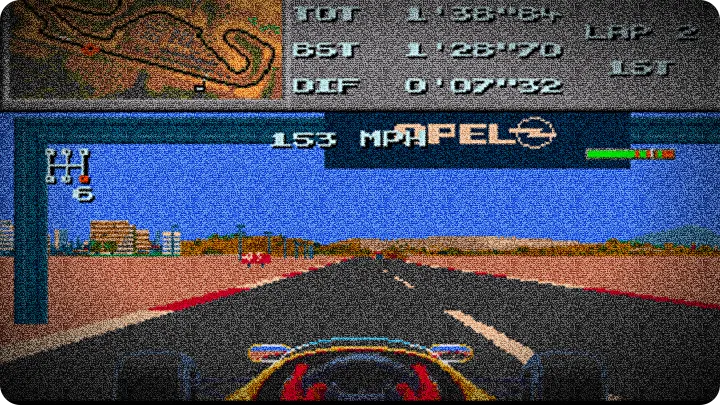
 My favorite memory is a two-player duel on Britain’s circuit. Split-screen may look chunky, but trading positions through the infield felt legendary. Small details like pit boards and cockpit sway over rumble strips add convincing realism.
My favorite memory is a two-player duel on Britain’s circuit. Split-screen may look chunky, but trading positions through the infield felt legendary. Small details like pit boards and cockpit sway over rumble strips add convincing realism.
 The season finale in Australia feels like a proper final boss. In our 12-lap Grand Prix, we carried a narrow points lead, and the rival pushed hard. It’s less about one unbeatable foe and more about fatigue and precision. Balancing setup choices and calm nerves creates a gripping climax.
The season finale in Australia feels like a proper final boss. In our 12-lap Grand Prix, we carried a narrow points lead, and the rival pushed hard. It’s less about one unbeatable foe and more about fatigue and precision. Balancing setup choices and calm nerves creates a gripping climax.
 There were rough edges, though. The AI can be predictable after you have raced the same circuit a few times; once you understand its lines it’s not a clever adversary. The scenery and crowd are repetitive, and collisions sometimes behave oddly — slight contact can send you spinning in ways that feel unfair. But these flaws rarely break the experience; they are more like the occasional static on a beloved VHS tape.
There were rough edges, though. The AI can be predictable after you have raced the same circuit a few times; once you understand its lines it’s not a clever adversary. The scenery and crowd are repetitive, and collisions sometimes behave oddly — slight contact can send you spinning in ways that feel unfair. But these flaws rarely break the experience; they are more like the occasional static on a beloved VHS tape.
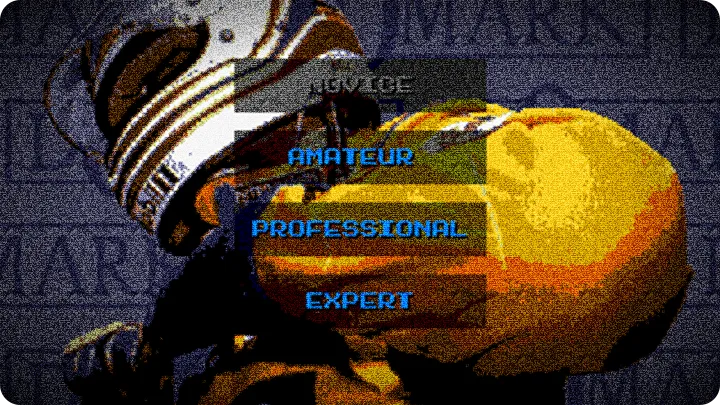
 Precisely. It is not flawless, but it delivers gratifying racing. I would have liked deeper tuning options and perhaps weather or pit strategy to deepen the Grand Prix mode, but for an official licensed title this era, it hits the essentials with competence.
Precisely. It is not flawless, but it delivers gratifying racing. I would have liked deeper tuning options and perhaps weather or pit strategy to deepen the Grand Prix mode, but for an official licensed title this era, it hits the essentials with competence.
 Final verdict? We enjoy it, we debate setups, and we keep coming back to try that last race in Australia again. It earns a solid B: a candid recommendation for fans of period-accurate racing — especially if you have a friend on the other controller.
Final verdict? We enjoy it, we debate setups, and we keep coming back to try that last race in Australia again. It earns a solid B: a candid recommendation for fans of period-accurate racing — especially if you have a friend on the other controller.
more info and data about Formula One provided by mobyGames.com

